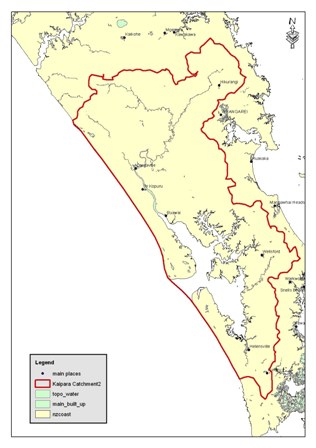Key calls for a Pūhoi–Makarau Line uprising

Colossal Kaipara Catchment: Curiously, in spite of being the southern hemisphere’s largest enclosed harbour, the Kaipara doesn’t boast a single large settlement, aside from those thoroughly in Auckland’s urban thrall. map Integrated Kaipara Harbour Management Group
There is nothing sacrosanct about the existing northern boundary of Rodney district.
It should possibly be changed. But definitely:
- not at this time; and
- never in such a way that it excludes Mahurangi–Matakana–Leigh from the region that it is functionally part of.
The first reason that no change should be made to the boundary is uncomplicated: Only when the governance arrangements for Northland are being formally examined, will be possible for alternative boundary positions be comprehensively and objectively considered. Then, and only then, could the costs of moving the boundary potentially be justified.
One of the significant costs to the proposed boundary change would occur through Kaipara District Council being compelled to administer the Rodney District Plan, along with its own. District plans cannot be imposed at the stroke of a pen—Rodney’s is still not fully operative, in spite of being worked on for twelve years.
Regardless of whether the Auckland–Northland boundary remains where it is or is redrawn further south—the Tamahunga Range is geographically compelling—there will be small communities that are neither wholly northward looking, nor wholly southward looking. Wellsford is midway between Whangārei and Auckland (85km and 81km respectively), but the metropolis inevitably exerts a greater influence on the town than does wee Whangārei, which is four kilometres closer. This is why, presumably, Wellsford did not clamour to the royal commission to be aligned to the north, in spite of boundaries being to the forefront of the inquiry’s terms of reference.
The call in Auckland for integrated planning dates back at least as far as 1954, but the clamour for more cohesive Auckland governance reached a crescendo with the launching of One Plan, in 2006. The One Plan initiative, based as it was on the four Auckland cities, begged the question as to how the hinterland of the metropolis would be governed. This prompted the Labour-led government to opt for a royal commission.
So, not to put too fine a point on it, Auckland regional planning has a 55-year history, culminating in a unitary authority solution. Northland, although it has had regional planning since 1989, has only recently begun to address its governance future. Not surprisingly the respective mayors would be more than happy to masters of all they survey—rankling as they do under the authority of their regional council.
Kaipara district, with its miniscule population, had little prospect of becoming a unitary authority—until the possibility of amalgamation with the northern part of Rodney district. If that had played out without community rebellion, it would possibly have qualified as the most the most unprecedentedly precipitous amalgamation in local government history. The Auckland region has a massive task ahead of it, implementing the bold new structure. And while all that is happening there will be plenty of time for what was Rodney County prior to 1972 (the southern boundary of which was the Waiwera River) to observe, or participate in, Northland region’s exploration of governance options. The needs of the enormously elongated Kaipara catchment, which extends from within a few kilometres of Kawakawa farther south than the Sky Tower, clearly cannot be a addressed by fashioning a unitary authority slavishly along catchment lines. The alternative may be something between the Hauraki Gulf Forum and the massive Murray–Darling Basin Authority.
The northern boundary of the new Auckland Council should be the existing Rodney District Council boundary, at least until the needs of the Kaipara Harbour catchment and Northland region can be adequately explored.
Saturday afternoon will no doubt give the Prime Minister the uprising he has hinted he would welcome.
